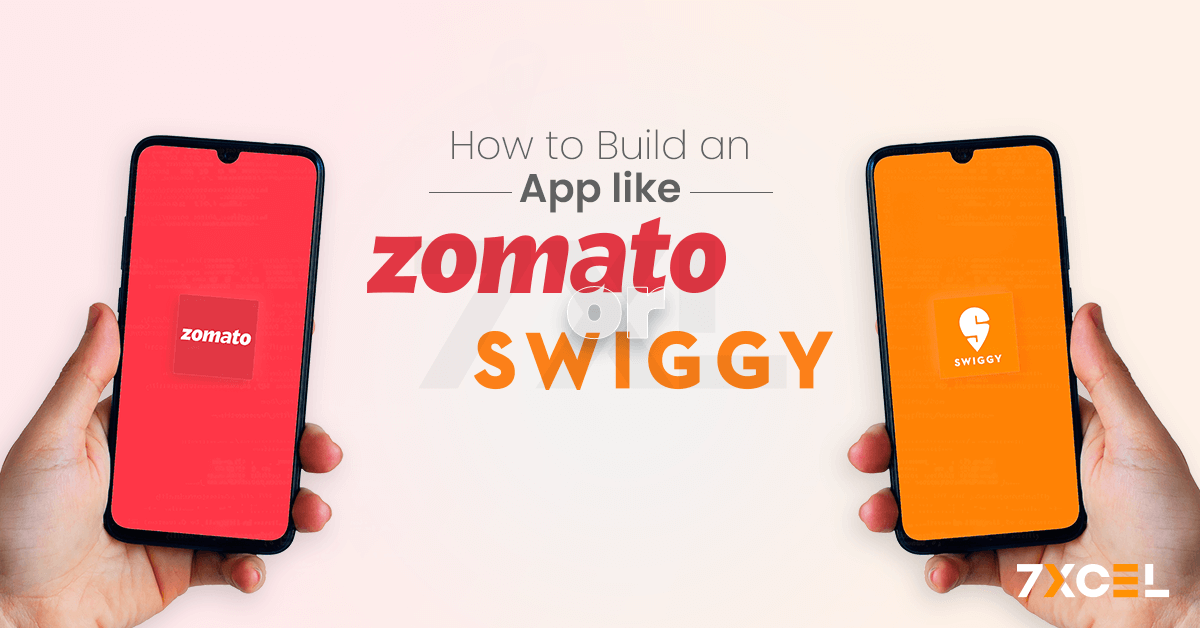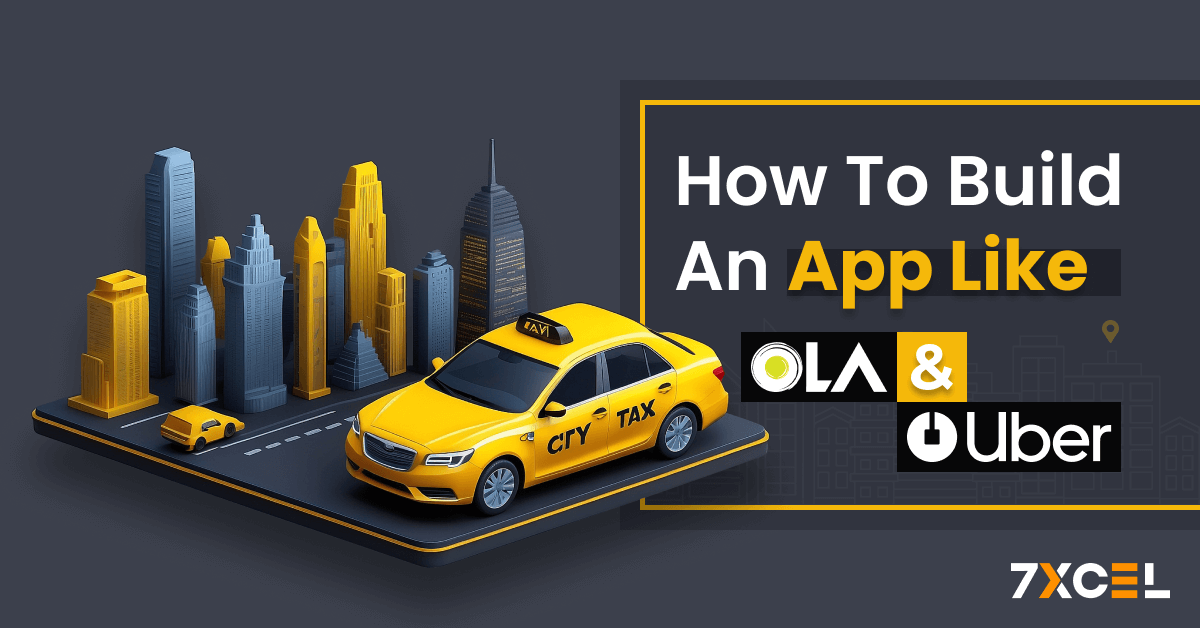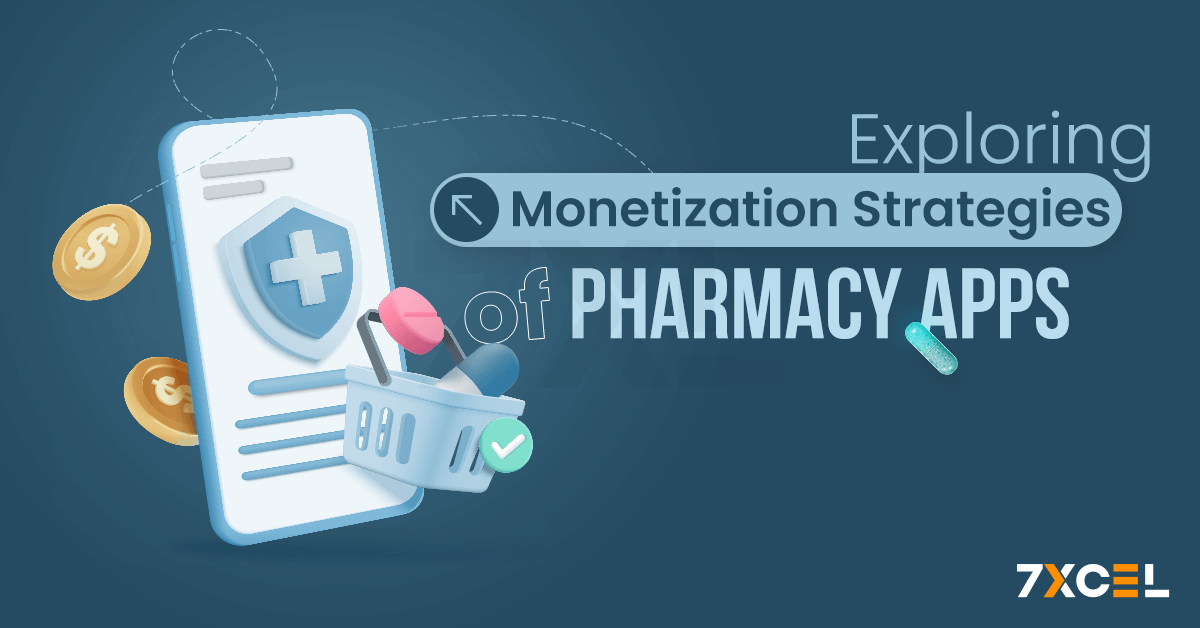Quick Summary:
Building an app like Zomato or Swiggy requires thorough market research, a clear unique value proposition, robust backend development, strong partnerships, rigorous testing, strategic launch, and continuous updates to ensure a seamless user experience and business success.
In this blog, we’re going to discuss📝
- Market Overview of the Food Delivery Industry
- Key Factors Driving this Growth of Food Delivery App include
- How Does Food Delivery Apps Work?
- Top Features of an Online Food Delivery App
- How Much Does it Cost to Develop an App Like Zomato or Swiggy?
- Tech Stack Used for Developing an Online Food Delivery App
- Important Revenue Methods for an Online Food Delivery App
- Monetization Strategies of Food Delivery Apps
The on-demand food delivery market has witnessed tremendous growth in recent years, with companies like Zomato and Swiggy leading the charge. As a business looking to tap into this lucrative space, building an app like Zomato or Swiggy can be a daunting task. However, with the right strategy and expertise, you can create a successful and scalable app that meets the evolving needs of your customers.
In this complete blog, The main procedures and recommended practices for creating an app similar to Swiggy or Zomato will be explained to you. From understanding the market landscape to designing a robust technology stack, we will cover everything you need to know to create a successful on-demand food delivery app.
Market Overview of the Food Delivery Industry
Due to shifting consumer preferences and technological developments, the food delivery sector has experienced rapid expansion. The worldwide market for online meal delivery is anticipated to reach $154.34 billion by 2023, rising at a CAGR of 11.51% between 2020 and 2023, according to recent research.
The success of platforms like Zomato and Swiggy highlights the potential for new entrants to capture significant market share by offering innovative solutions and exceptional customer service.
Key Factors Driving this Growth of Food Delivery App include:
- Convenience: Consumers prefer the ease of ordering food from their favorite restaurants via mobile apps.
- Technological Advancements: Innovations in mobile technology, GPS tracking, and online payments have made food delivery more efficient.
- Pandemic Impact: The COVID-19 pandemic accelerated the adoption of online food delivery services as people sought safe and convenient dining options.
How Does Food Delivery Apps Work?
Food delivery apps streamline the process of ordering food and getting it delivered to the customer’s doorstep. Here’s a detailed breakdown of how these apps function:
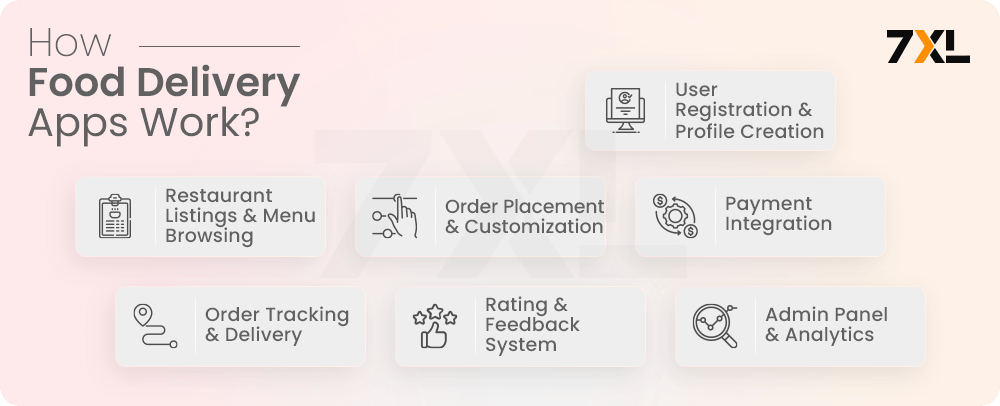
User Registration and Profile Creation
- Customers: Users download the app, sign up using their email or phone number, and create profiles. They can save delivery addresses and payment methods for a faster checkout process.
- Delivery Personnel: Couriers register on the platform, providing necessary documents for verification. They undergo background checks to ensure reliability and safety.
Restaurant Listings and Menu Browsing
- Product Catalog: Customers browse a wide range of restaurants and menu items categorized for easy navigation. They can search for specific dishes or explore different cuisines.
Order Placement and Customization
- Ordering: Customers select items, customize their orders (e.g., adding special instructions), and place the order.
- Real-Time Updates: Real-time updates on are provided by the app for order status, from preparation to delivery.
Payment Integration
- Secure Payments: The app supports multiple payment methods, including credit/debit cards, digital wallets, and cash on delivery. Payment gateways like Stripe, PayPal, and Paytm are commonly used.
Order Tracking and Delivery
- GPS Tracking: Customers can track the real-time location of their order through the app’s GPS functionality. They receive updates on the estimated delivery time and the courier’s progress.
Rating and Feedback System
- Feedback: Customers can evaluate their experience after delivery and provide feedback on the service and food quality. This helps maintain high standards and improves future services.
Admin Panel and Analytics
- Management Dashboard: The app includes an admin panel for managing restaurants, monitoring orders, processing payments, and handling customer inquiries.
- Analytics and Reporting: Advanced analytics tools provide insights into user behavior, order trends, and revenue, helping businesses make data-driven decisions
Top Features of an Online Food Delivery App
Developing a successful online food delivery app requires incorporating features that ensure a seamless and enjoyable experience for users. Here are the key food delivery app features that are essential for an online food delivery app, each explained with an introductory paragraph:
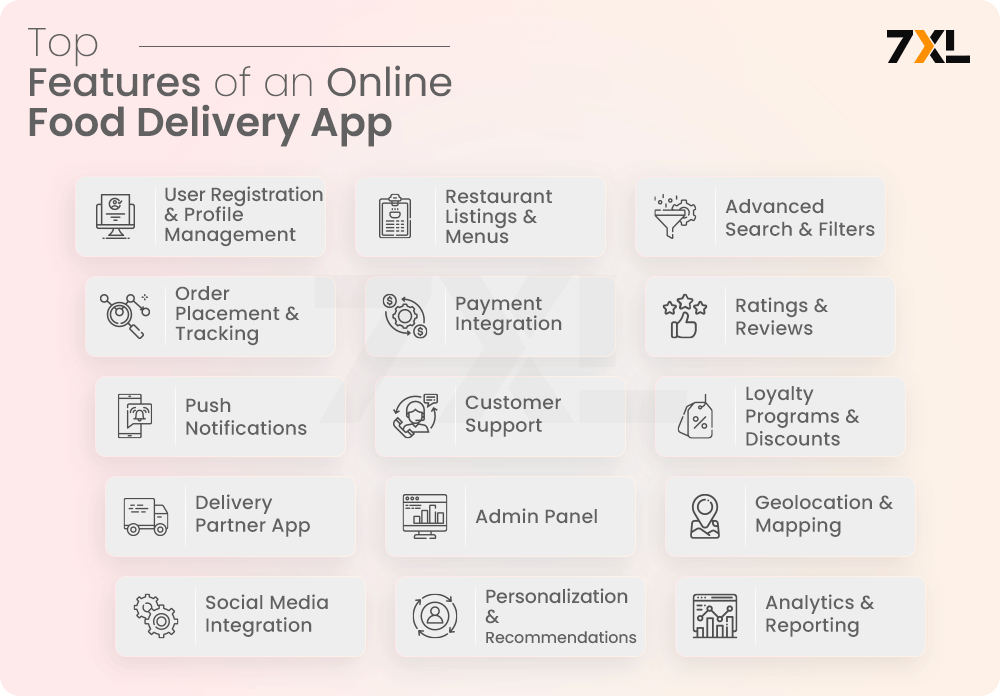
1. User Registration and Profile Management
A smooth onboarding process is crucial to attract and retain users. Simplifying user registration and profile management ensures that users can quickly start using the app without any hassle.
- Easy Sign-Up/Login: For a simple and fast signup procedure, users should be able to use their mobile number, email address, or social network accounts.
- Profile Management: Users should have the ability to manage their profiles, including updating personal information, adding delivery addresses, and managing payment methods.
2. Restaurant Listings and Menus
Providing comprehensive and detailed restaurant listings and menus is vital for user satisfaction. This feature helps users make informed choices & enhances their overall experience.
- Comprehensive Listings: Provide detailed listings of all available restaurants, including names, cuisines, ratings, and delivery times.
- Menu Display: Detailed menus with item descriptions, prices, images, and availability status to help users make informed decisions.
3. Advanced Search and Filters
A robust search and filter system is essential to help users find their preferred food and restaurants quickly. It enhances user experience by making the app more navigable and user-friendly.
- Search Functionality: A powerful search bar that allows users to search for specific dishes, restaurants, or cuisines.
- Filters and Sorting: Options to filter search results based on criteria like price range, ratings, delivery time, and dietary preferences.
4. Order Placement and Tracking
Ensuring a smooth and transparent order placement and tracking process is key to user satisfaction. It allows users to place orders effortlessly and stay updated on their order status.
- Seamless Order Placement: An intuitive interface for users to place orders quickly, select delivery or pickup options, and apply discounts or promo codes.
- Real-Time Tracking: GPS tracking to allow users to track their order status from preparation to delivery, providing estimated delivery times and live updates.
5. Payment Integration
Secure and versatile payment integration is critical for user convenience. Providing multiple payment options and ensuring transaction security builds user trust and encourages app usage.
- Multiple Payment Options: Support for many payment options, such as COD (cash on delivery), digital wallets, credit/debit cards, and net banking.
- Secure Transactions: Ensuring secure payment processing with encryption and compliance with payment standards to protect user data.
6. Ratings and Reviews
Allowing users to provide feedback through ratings and reviews fosters transparency and trust. It also helps maintain service quality by highlighting areas for improvement.
- User Feedback: Allow users to rate their dining experience and leave reviews for restaurants and delivery services.
- Review Display: Display user ratings and reviews to help others make informed choices about restaurants and dishes.
7. Push Notifications
Push alerts are an effective means of keeping users engaged and informed. They ensure users receive timely updates about their orders and promotional offers.
- Order Updates: Send real-time notifications to users about their order status, including confirmation, preparation, and delivery.
- Promotions and Offers: Notify users about special promotions, discounts, and personalized offers to keep them engaged and encourage frequent usage.
8. Customer Support
Providing robust customer support is essential for resolving user issues promptly and maintaining a high level of user satisfaction. It helps build a loyal user base by addressing their concerns effectively.
- In-App Support: Provide in-app customer support through chat, email, or phone to resolve user queries and issues promptly.
- FAQs and Help Center: A comprehensive help center with frequently asked questions and troubleshooting guides.
9. Loyalty Programs and Discounts
Implementing loyalty programs and offering discounts can significantly boost user retention and engagement. These incentives encourage repeat usage and help in building a loyal customer base.
- Rewards and Points: Implement loyalty programs that allow consumers to accumulate points for each purchase, which they can then use to get freebies or discounts.
- Referral Programs: By providing incentives for successful referrals, you can encourage users to recommend friends and family.
10. Delivery Partner App
A dedicated app for delivery partners is essential to streamline the delivery process and ensure efficiency. It helps in managing orders, navigation, and communication with customers.
- Separate Interface for Delivery Partners: A dedicated app for delivery partners with features like order management, navigation assistance, earnings tracking, and communication with customers and support.
- Delivery Partner Registration and Profile: Allow delivery partners to sign up, complete their profiles, and submit necessary documentation for verification.
11. Admin Panel
An admin panel is crucial for managing the app’s operations efficiently. It provides the necessary tools for monitoring and controlling various aspects of the app, ensuring smooth functioning.
- Comprehensive Management: An admin panel for managing users, restaurants, orders, and delivery partners. It should provide real-time analytics, reporting, and customer support tools.
- Content Management System (CMS): A CMS to manage restaurant listings, menu items, promotions, and notifications.
12. Geolocation and Mapping
Geolocation and mapping features are critical for accurate delivery and efficient route planning. They enhance user experience by providing real-time updates and ensuring timely deliveries.
- Location Services: Utilize GPS for accurate user location detection, restaurant search based on proximity, and efficient route planning for delivery partners.
- Map Integration: Integration with map services like Google Maps for real-time navigation and tracking.
13. Social Media Integration
Social media integration enhances user engagement and allows for easier sign-ups and sharing. It helps in leveraging social networks for wider reach and better user acquisition.
- Social Sharing: Allow users to share their food experiences, reviews, and favorite restaurants on social media platforms.
- Social Logins: Make it possible for users to register more quickly by allowing them to do so with their social media accounts.
14. Personalization and Recommendations
Personalization and recommendation features enhance user experience by offering tailored suggestions. They help in increasing user engagement and satisfaction by providing relevant options.
- Personalized Recommendations: Provide individualized restaurant & cuisine recommendations using machine learning algorithms based on past orders and user preferences.
- Customizable Preferences: Allow users to set dietary preferences, favorite cuisines, and preferred delivery times for a tailored experience.
15. Analytics and Reporting
Analytics & reporting tools are essential for data-driven decision-making. They help in tracking performance, understanding user behavior, and optimizing the app for better results.
- User Behavior Analytics: Track user behavior and preferences to improve the app’s features and user experience.
- Order and Sales Reports: Generate detailed reports on orders, sales, and user engagement for data-driven decision-making.

Interested to develop a standout food delivery app?
At 7xcel, our on-demand food delivery app development services empower food business owners to rapidly enhance brand visibility and boost sales.
How Much Does it Cost to Develop an App Like Zomato or Swiggy?
Building an app like Zomato or Swiggy involves a range of costs depending on various factors such as the app’s complexity, features, design, development team, and the technology stack used. Partnering with a specialized Food Delivery App Development Company can help in optimizing these costs while ensuring high-quality outcomes.
Their expertise can guide the efficient allocation of resources, selecting the right technologies, and incorporating essential features like real-time tracking and secure payments. Here’s a comprehensive breakdown of the cost components involved in developing an online food delivery app:

1. Market Research and Planning
- Market Research: It can cost anything from $5,000 to $15,000 to conduct comprehensive market research to comprehend the target market, competitors, and industry trends.
- Business Analysis: Detailed business analysis to define requirements, project scope, and a clear value proposition may range from $10,000 to $20,000.
2. UI/UX Design
- Wireframing and Prototyping: Creating wireframes and prototypes for the app’s user interface can cost around $5,000 to $15,000.
- Visual Design: Designing a user-friendly and visually appealing interface may cost between $10,000 to $30,000 depending on the complexity.
3. Backend Development
- Server-Side Development: Developing a robust backend to handle user data, restaurant listings, order management, and payment transactions can cost between $20,000 to $60,000.
- Database Integration: Setting up and integrating databases to store user information, menus, and order details may cost around $10,000 to $20,000.
- API Development: Developing APIs for communication between the app’s frontend and backend, and integrating third-party services can cost between $10,000 to $30,000.
4. Frontend Development
- Mobile App Development: Developing native apps for iOS and Android platforms typically costs between $20,000 to $60,000 per platform.
- Web Development: If a web platform is also required, it can cost an additional $15,000 to $30,000.
- Cross-Platform Development: Using frameworks like React Native or Flutter for cross-platform development may cost between $30,000 to $50,000.
- User Registration and Profiles: Implementing secure and user-friendly registration and profile management features can cost between $5,000 to $10,000.
5. Key Features Integration
- Restaurant Listings and Menus: Integrating comprehensive restaurant listings and detailed menus may cost around $10,000 to $20,000.
- Search and Filters: Advanced search and filter functionalities can cost between $5,000 to $15,000.
- Order Placement and Tracking: Developing seamless order placement and real-time tracking features can cost between $10,000 to $30,000.
- Payment Gateway Integration: Integrating multiple payment options securely might cost around $10,000 to $20,000.
- Ratings and Reviews: Adding a ratings and reviews system for restaurants and delivery services may cost between $5,000 to $10,000.
- Push Notifications: Implementing push notifications for order updates and promotions can cost around $5,000 to $10,000.
- Customer Support: Providing in-app customer support features can cost between $5,000 to $15,000.
- Loyalty Programs and Discounts: Developing loyalty and referral programs may cost around $5,000 to $15,000.
- Delivery Partner App: Creating a dedicated app for delivery partners with necessary features can cost between $15,000 to $30,000.
- Admin Panel: Developing a comprehensive admin panel for managing the app’s operations can cost between $10,000 to $20,000.
- Geolocation and Mapping: Integrating location services and real-time navigation features may cost around $5,000 to $15,000.
- Social Media Integration: Adding social media sharing and login functionalities can cost between $5,000 to $10,000.
- Personalization and Recommendations: Implementing personalized recommendations using machine learning can cost around $10,000 to $20,000.
- Analytics and Reporting: Adding analytics and reporting tools for data-driven decision-making may cost between $5,000 to $10,000.
6. Testing and Quality Assurance
- Functional Testing: Ensuring all features work correctly can cost between $10,000 to $20,000.
- Performance Testing: Testing the app’s performance under various conditions may cost around $5,000 to $15,000.
- Usability Testing: Conducting usability testing to ensure a smooth user experience can cost between $5,000 to $10,000.
- Security Testing: Performing security testing to identify and fix vulnerabilities might add an additional $5,000 to $10,000.
7. Deployment and Launch
- App Store Submission: The cost of submitting the app to the App Store and Google Play can be around $1,000 to $5,000, including fees and initial promotion.
- Marketing and Promotion: Initial marketing efforts to promote the app may range from $10,000 to $30,000.
8. Post-Launch Maintenance and Updates
- Regular Updates: Providing regular updates and feature enhancements can cost around $10,000 to $20,000 annually.
- Customer Support: Offering 24/7 customer support may cost between $10,000 to $20,000 annually.
- Server Maintenance: Ongoing server maintenance and hosting can cost around $5,000 to $15,000 annually.
Total Estimated Cost
Considering all these factors, the total cost to develop an app like Zomato or Swiggy can range from $150,000 to $400,000 or more, depending on the specific requirements and complexity of the app.
Tech Stack Used for Developing an Online Food Delivery App
Choosing the right technology stack is critical for the successful development of an online food delivery app like Zomato or Swiggy. The tech stack must ensure scalability, performance, security, and a seamless user experience. Here’s a detailed breakdown of the technologies used in different components of the app:
| Component | Technology | Description |
| Frontend Development | ||
| iOS Development | Swift, Objective-C | Languages for iOS development |
| UIKit, CoreLocation, MapKit | Frameworks for UI components, location services, and maps | |
| Xcode | Integrated Development Environment (IDE) for iOS | |
| Android Development | Kotlin, Java | Languages for Android development |
| Android SDK, Google Maps SDK | Frameworks for Android development and maps | |
| Android Studio | IDE for Android development | |
| Cross-Platform Development | React Native, Flutter | Frameworks for building cross-platform apps |
| JavaScript (React Native), Dart (Flutter) | Languages for cross-platform development | |
| Backend Development | ||
| Server-Side Languages | Node.js, Python (Django/Flask), Ruby on Rails | Languages and frameworks for backend development |
| Database | PostgreSQL, MySQL, MongoDB, Cassandra | Relational and NoSQL databases |
| Web Servers | Nginx, Apache | Web servers for handling HTTP requests |
| Hosting & Cloud Services | AWS, Google Cloud Platform (GCP), Microsoft Azure | Cloud platforms for hosting and scalability |
| APIs and Integrations | ||
| Maps and Geolocation | Google Maps API, Mapbox | APIs for geolocation and maps |
| Payment Gateways | Stripe, PayPal, Braintree | Payment processing services |
| Communication Services | Twilio, Firebase Cloud Messaging (FCM) | SMS, voice, video, and push notifications |
| Real-Time Communication | Socket.io, WebRTC | Real-time data and communication |
| Admin Panel & Dashboard | ||
| Web Development Frameworks | React.js, Angular, Vue.js | Frameworks for building admin panels |
| Admin Dashboard Templates | AdminLTE, Metronic | Pre-built templates for admin interfaces |
| Data Analytics and Monitoring | ||
| Analytics Tools | Google Analytics, Mixpanel | Tools for tracking user behavior and engagement |
| Monitoring Tools | New Relic, Datadog | Application performance monitoring and analytics |
| Security Measures | ||
| Authentication and Authorization | OAuth, JWT (JSON Web Tokens) | Secure authorization and authentication mechanisms |
| Data Encryption | SSL/TLS, AES | Encryption standards for secure data transmission and storage |
| Regular Security Audits | Security audits and vulnerability assessments | Regular checks to identify and mitigate security risks |
Important Revenue Methods for an Online Food Delivery App
Building a successful online food delivery app requires not only providing excellent service but also implementing effective revenue streams. Here are some of the most important revenue methods for an online food delivery app:

1. Commissions on Orders
Charging a commission on each order placed through the app is a primary revenue source.
- Percentage-Based Commissions: Typically, the app charges restaurants a percentage of the total order value, ranging from 15% to 30%.
- Fixed Fee per Order: Alternatively, some apps may charge a fixed fee per order, ensuring steady income regardless of the order value.
2. Delivery Fees
Charging customers for the delivery service is a significant revenue stream.
- Standard Delivery Fee: Customers pay a fee for each delivery, which varies based on factors like distance, time, and location.
- Surge Pricing: During peak hours or high-demand periods, delivery fees might increase to manage demand and ensure timely service.
3. Subscription and Membership Plans
Offering subscription and membership plans provides a steady stream of recurring revenue.
- Customer Subscriptions: Plans that offer benefits like free delivery, exclusive discounts, and early access to promotions (e.g., Zomato Gold, Swiggy Super).
- Restaurant Memberships: Restaurants can pay for premium listings, priority placement in search results, and additional promotional features.
4. Advertising and Promotions
In-app advertising and promotional partnerships are effective ways to generate additional revenue.
- In-App Advertising: Display ads from third-party businesses within the app, such as banner ads, video ads, or sponsored listings.
- Featured Listings: Restaurants can pay to be featured prominently in search results or special sections of the app.
- Partner Promotions: Collaborate with brands for exclusive promotions and offers, such as discounts on certain payment methods or credit card partnerships.
5. Surge Pricing
Implementing surge pricing during high-demand periods can significantly boost revenue.
- High-Demand Periods: Increase prices during peak times, bad weather, or special events when the demand for deliveries is higher.
- Algorithm-Driven: Use advanced algorithms to calculate optimal price surges based on real-time demand and supply, maximizing revenue.
Focusing on these key revenue methods will help ensure the financial success of your online food delivery app. By leveraging commissions on orders, delivery fees, subscription plans, advertising, and surge pricing, you can create a sustainable and profitable business model that attracts users and partners alike.
Monetization Strategies of Food Delivery Apps
To ensure the long-term success of your app, it’s essential to develop a sustainable monetization strategy. Here are some key strategies to consider:
- Commission-based Model: Charge a commission on each successful order, typically ranging from 15% to 25% of the total order value.
- Subscription-based Model: Offer a premium subscription plan that provides users with additional benefits, such as free or discounted delivery, exclusive offers, and priority support.
- Dynamic Pricing: Adjust delivery fees based on factors like demand, time of day, and surge pricing during peak hours.
- Advertising and Partnerships: Generate revenue through in-app advertising, sponsored product placements, and strategic partnerships with brands and retailers.
- Data Monetization: Leverage user preferences, purchase patterns, and market trends to offer data-driven insights and services to third-party organizations.
Conclusion
Building an app like Zomato or Swiggy requires a deep understanding of the market landscape, a robust technology stack, and a range of key features and functionalities. By following the best practices outlined in this guide, you can create a successful and scalable app that meets the evolving needs of your customers. Remember to prioritize user experience, leverage data insights, and develop a sustainable monetization strategy to ensure the long-term success of your app.
